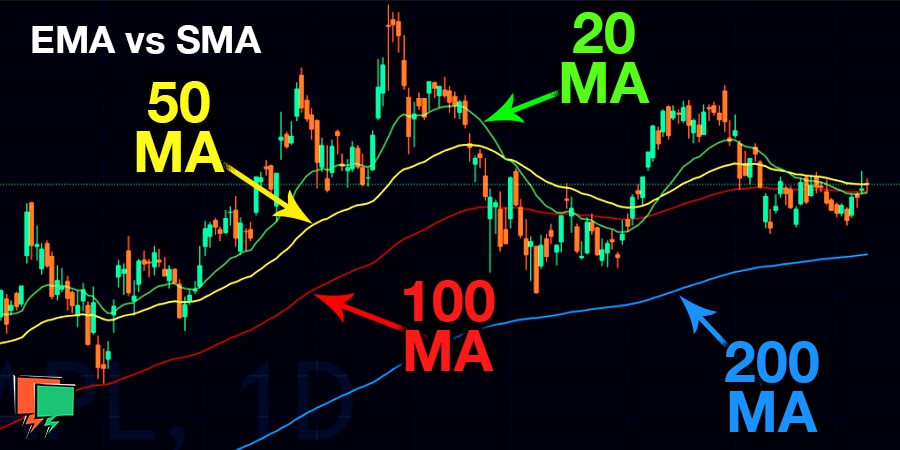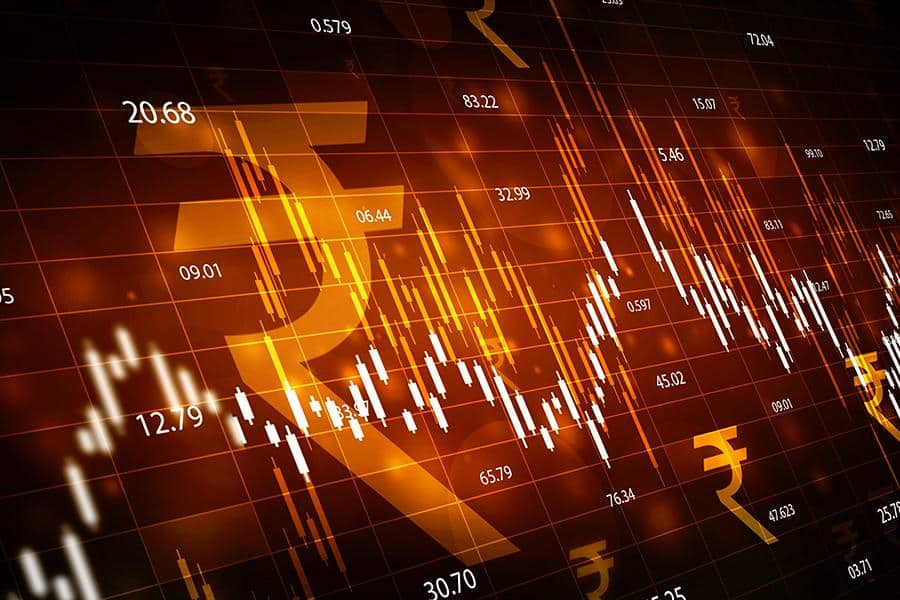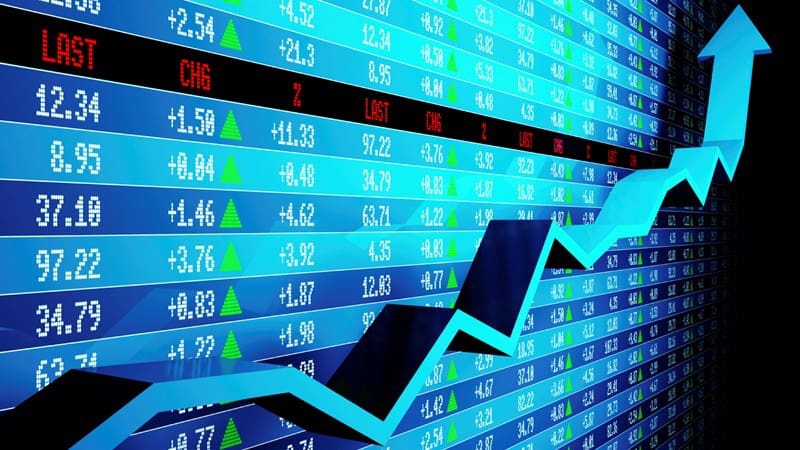Welcome to the trader’s arsenal where top financial market analysis indicators turn the tide of day-to-day trading. Every move counts. That’s why understanding the crux of these tools—be it the smooth sail guided by moving averages or the sharp insights from volume analysis—is pivotal for your success.
As traders, hunting for the right moment to strike is our game. Enter oscillators and momentum indicators: our crystal ball to time the market’s heartbeat. And let’s not forget patterns; these indicators stitch together a tapestry of market trends, predicting the path less traveled. Gear up, because we are about to unveil the secret weapons that keep seasoned traders one step ahead of the game.
Demystifying Moving Averages: The Trader’s Compass
The Power of Simple and Exponential Moving Averages
Moving averages are key to trading. They smooth out prices over time. This tells us the main trend. Two kinds of moving averages matter a lot. Simple Moving Averages (SMA) and Exponential Moving Averages (EMA). SMA gives equal weight to all prices in its period. EMA gives more weight to recent prices. This makes EMA quicker to show price changes.
Why do these averages help traders? They show support and resistance levels. This means they help us guess where prices might stop or reverse. SMA is good for seeing the long run trends. EMA is tops for fast trading moves. Using both lets traders get a clear view of the market.
Traders love moving averages because they’re easy to use. Even kids can plot them on a chart. Imagine being on a boat in the sea at night. A moving average is like your compass. It points to where you are going. It keeps you on track and helps you steer clear of trouble.
Moving Averages in Action: Signals and Strategies
Moving averages give signals on when to buy or sell. A common signal is the crossover. When a short-term MA crosses over a long-term one, it’s a buy signal. If it goes the other way, it’s time to sell. These crossovers are like traffic lights for traders. They say go or stop.
There is a cool trick called the moving average ribbon. It uses many MAs together. When they spread out, it’s often a strong trend. When they come close, a trend might change soon. It’s like watching birds fly together. They spread out in the sky when the wind is strong.
Traders also look at the angle of MAs. A rising MA means “up we go!” A falling MA means “look out below!” And if it’s flat, the market might be taking a nap.
But remember, using moving averages is not magic. They can’t tell the future. They’re just tools to see trends. Always use them with other tools. Like volume analysis and price action. This way, you can make better choices.
In the end, moving averages are traders’ secret weapons. They help us find the path in a messy market. Understanding them is the first step to being a smart trader. Just like a good compass, they show us the way.
Volume Analysis: Unlocking Market Sentiments
Interpreting Volume Spikes and Drops
When trading, seeing volume spikes is like hearing a market shout. A spike means lots of trades. If prices jump with high volume, it’s like traders all agree on the price move. But if there’s a drop, it’s as if traders have doubts. This can signal a price change.
Volume shows the market’s voice. It can hint at a big move. If volume rises and prices do too, it means strength. If volume is high but prices drop, be cautious. It may show that the trend could change soon.
Combining Volume with Price Movements for Confirmation
Volume and price together tell a story. They’re like best friends that help traders. Adding volume to price moves is like adding evidence to a case. It makes the move more believable.
If you see prices go up with more volume, trust the trend. If you see price go up but volume is low, watch out. The trend could be weak. This mix helps traders make smart choices. It’s key for buy or sell decisions.
In trading, using these tools makes you sharp. It’s like having a secret in your pocket. It helps you guess where prices will go. When you get it, you can lead in the trading game.
Oscillators and Momentum: Timing the Market
RSI: Identifying Overextended Markets
Imagine you’re in a game of tug-of-war. RSI acts like a coach, telling you if one team is too tired or too strong. It’s a sign we traders use to see if stocks are like items at a sale: too cheap or too costly. When the RSI hits up past 70, a stock might be overbought. That means a lot of buying happened. Now, the stock’s price might drop, like after a sugar rush. If it dives under 30, the stock could be oversold. People may have sold the stock out of fear, but it can bounce back. Think of it as a super ball on tile: drop it low, watch it fly high!
Stochastic Oscillator: Capturing Market Cycles and Potential Reversals
Now, let’s chat about the stochastic oscillator. It’s a fancy tool that’s pretty easy to grasp. You can think of it like a weather app predicting rain or shine for stocks. It helps by looking back at a stock’s highest and lowest prices over a time, then tells us if it’s closing in on the peak or bottoming out. The number it spits out helps signal if the stock’s cycle is swinging up or down.
It’s neat because it can help you catch a stock’s U-turn before it happens. If the line crosses over 80, watch out, we might expect a drop. Below 20 and it’s saying, “Hey, this might shoot up soon.” Web the lines criss-cross in this zone, traders like us take notice. It’s like a secret knock telling us when to enter or exit a trade.
Using RSI and the stochastic oscillator means catching the wave at the right time. But remember, these tools are like buddies giving you hot tips. You don’t act on a friend’s advice without thinking it through, right? Same goes here. We use these signals with other clues for smarter trades, like combining peanut butter with jelly – both are great on their own, but together, they make a mighty fine sandwich.
Patterns and Indicators: The Tapestry of Trends
The Role of Candlestick Patterns in Confirming Market Sentiment
Ever look at market charts and see shapes like hammers or stars? We call these candlestick patterns. They tell us what traders think and feel. Reading these patterns helps us predict where prices might go next.
You may wonder, what is the importance of volume analysis in trading? It’s like a heartbeat; it shows life in the market. High volume means a lot of trading is happening. It can confirm if a candlestick pattern really means a big shift is coming.
Using Bollinger Bands is another great trick. These bands squeeze together or spread apart. They show us if the market is quiet or about to jump. Imagine the market is a rubber band. The more we stretch it, the stronger it snaps back. Bollinger Bands help us see when that snap might come.
Now, let’s mash things up with stock market momentum oscillators. These tools are like detectives. They spot clues that a trend might change. The MACD indicator can whisper if a stock is tired of climbing or falling. RSI, short for Relative Strength Index, screams when a stock has gone too high or too low.
Have you heard about the Fibonacci retracement levels? They’re like magic numbers. These levels show us where a price might stop falling and start bouncing back. This helps us guess the market’s next move. By the way, these levels come from an old math trick. This trick can be found all over in nature too!
Pivot Points and Fibonacci: Mapping the Market’s Next Move
Chalk lines on a playground show you where the game happens. That’s what pivot points do for us in trading. They draw lines on our charts to show where the price may hit a wall or find a trampoline.
Market sentiment analysis is also a clever tool. It’s like reading the room during a big game. We feel if people are scared or excited. This vibe can push prices up or down.
Remember, we’re on a treasure hunt. We mix and match these clues to find the gold. And that gold is a smart trade that can make us money. Before we jump in, we check our map – that’s our chart with all the patterns and indicators.
Adventures in trading never end. With each chart and every trade, we learn and earn. Our secret weapons? Patterns and indicators that show us the tapestry of trends. They guide us through the exciting world of trading. Now, ready your maps and set sail into the market. Who knows what treasure your next trade could bring?
In this post, we explored key tools traders use to navigate markets. We broke down moving averages, showing how simple and exponential types guide us on trends and timing. We saw how they signal when to jump in and out of trades. Next, we tackled volume analysis, a critical piece in reading market moods. We learned to spot important volume changes and put price and volume together to confirm our moves.
From there, we dove into oscillators like RSI and Stochastic, tools that help us see when markets might flip direction. They signal when things are too hot or too cold, helping us find just-right entry and exit points. Lastly, we pieced together the market’s story with patterns and indicators. Candlesticks and tools like pivot points and Fibonacci give us a clear map for where the market could head next.
My final thought? These methods aren’t just numbers and graphs; they’re a trader’s compass for stormy financial seas. Use them well, and they can help you steer toward success. Remember, in trading, knowledge is power – and now you have more power to make smart moves.
Q&A :
What are the most reliable indicators for financial market analysis?
Financial market analysis relies heavily on a variety of indicators to gauge market behavior and economic health. Among the most reliable are the Moving Average (MA), Relative Strength Index (RSI), and the Moving Average Convergence Divergence (MACD). These indicators help traders identify trends, momentum, and potential turning points in the markets.
How can traders use technical indicators to predict market movements?
Traders often use technical indicators by setting specific parameters and thresholds to signal potential buy or sell opportunities. Indicators like the RSI, for example, help identify overbought or oversold conditions, suggesting a reversal might be near. Meanwhile, Bollinger Bands provide insight on market volatility and price levels relative to standard deviations.
What is the difference between leading and lagging indicators in financial market analysis?
Leading indicators are designed to predict future market moves and economic trends by changing before the economy as a whole changes. Examples include the Consumer Confidence Index or the stock market itself. Lagging indicators, on the other hand, follow an event – they tend to change after the economy as a whole does, offering insight into past performance, such as unemployment rates or Gross Domestic Product (GDP).
Why are volume indicators important in financial market analysis?
Volume indicators are crucial because they help analysts understand the intensity of a price trend and the conviction of traders in the buying/selling process. High volume typically confirms the strength of a trend, whereas low volume may signal a lack of interest or weakness in the movement. Indicators like On-Balance Volume (OBV) and the Volume Oscillator provide deeper insight into market trends.
Can economic indicators also be used for financial market analysis?
Yes, economic indicators are a vital part of financial market analysis as they reflect the overall economic health and activity, which directly influences the markets. Indicators such as inflation rates, employment metrics, interest rates, and GDP growth are closely monitored by market participants for clues about future monetary policy and economic trends.



